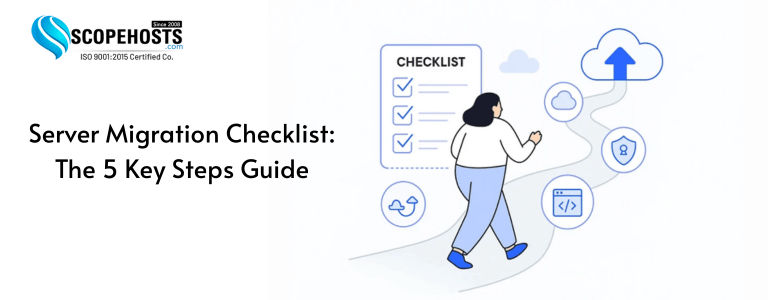Table of Contents
- Introduction
- Step 1: Planning and Assessment
- Step 2: Choosing the Right Migration Strategy
- Step 3: Preparing for Migration
- Step 4: Execution of Migration
- Step 5: Post-Migration Validation and Optimization
- Conclusion
Introduction
Server migration is the critical process of moving data, applications, and workloads from one server environment to another. Whether the goal is to upgrade infrastructure, move to the cloud, or consolidate systems, a successful migration hinges on meticulous planning to minimise downtime and ensure business continuity. This blog outlines a five-step checklist to guide you through a secure and efficient server migration.

Step 1 : Planning and Assessment
A comprehensive review of your current IT infrastructure is the first step and key to a successful migration. First, identify the primary business objectives driving the migration, such as performance improvements, cost reduction, security enhancements, or a move to a cloud-hosted environment. Next, gain visibility into all applications, databases, and services currently running on the server to understand dependencies. As part of this step, perform a risk assessment and identify contingency plans to mitigate potential failures. You will also need to establish a detailed budget to avoid unexpected costs. It is also critical to consider compliance and legal requirements in highly regulated industries to ensure data safety.

Step 2 : Choosing the Right Migration Strategy
Selecting the right migration strategy is crucial for success. In a “Lift and Shift” strategy, you move applications using minimal changes to the underlying architecture. This is “quick,” but organizations will not see significant efficiency in the process. A more mature option is called “Replatforming,” a process that has the organizations optimize applications during the migration process to better utilize the new infrastructure. In instances where applications need extensive improvement, the process of “Refactoring” typically involves redesigning an application to be cloud-native so that applications can leverage the technologies available in the cloud, significantly increasing the potential scalability, availability, and performance of the application. A Hybrid Approach involves migrating non-critical workloads first and selectively refactoring key applications over time. This approach consists of migrating workloads that aren’t considered “critical” to the organization first, and selectively refactoring key applications over time. In addition to migration strategies, choosing the right cloud provider, such as AWS, Google Cloud, or Azure, will be an important consideration in a successful migration.

Step 3 : Preparing for Migration
Adequate preparation is key to a disruption-free migration. Begin by developing a good backup strategy to protect your data and applications. Next, conduct pre-migration testing to address any incompatibility or performance bottlenecks. After this, you should have a rollback plan in case you need to revert to the original server. Additionally, training IT staff and end-users can help minimize disruption during migrations. Finally, configure network and security settings in the target environment in advance to prevent introducing new vulnerabilities during the migration.

Step 4 : Execution of Migration
The migration process should be carefully managed to mitigate disruption due to downtime or data integrity issues. To minimize disruption for users, the migration could be scheduled for off-peak hours. Communication with stakeholders is of the utmost importance throughout the process. Use secure transfer methods, including encryption and checksum verification, to guarantee data integrity and accuracy. Continuously monitor performance during the migration to quickly identify issues such as software conflicts, database errors, or latency. After the migration, conduct compatibility tests to verify that all applications and services are functioning correctly.

Step 5 : Post-Migration Validation and Optimization
Once the migration is complete, thorough validation is essential. This involves extensive testing to confirm that systems are functioning properly. Tuning for performance, optimization of databases, and caching techniques can help improve efficiency in the new environment. Conduct security audits to verify compliance with relevant regulations and internal policies. Gather feedback from IT staff and end-users to identify areas for improvement. Implement long-term monitoring to ensure performance continues to meet business expectations.
Conclusion
While server migration is a complex undertaking, it is essential for modernizing IT infrastructure and driving business growth. By following a structured methodology—planning, choosing a strategy, preparing, executing, and optimizing—organizations can execute migrations with significantly less disruption. A successful migration results in a more performant, cost-effective, and resilient IT environment. Thorough documentation ensures future migrations can be executed with greater confidence, especially as technology continues to change and evolve.







